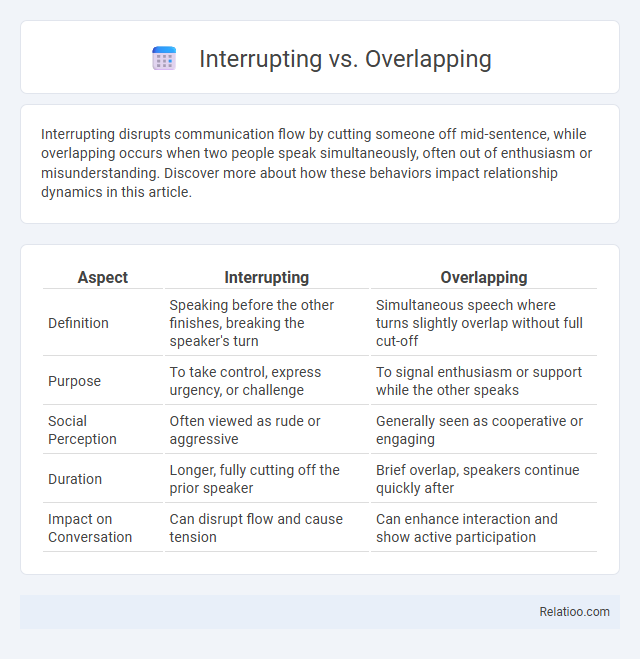Interrupting disrupts communication flow by cutting someone off mid-sentence, while overlapping occurs when two people speak simultaneously, often out of enthusiasm or misunderstanding. Discover more about how these behaviors impact relationship dynamics in this article.
Table of Comparison
| Aspect | Interrupting | Overlapping |
|---|---|---|
| Definition | Speaking before the other finishes, breaking the speaker's turn | Simultaneous speech where turns slightly overlap without full cut-off |
| Purpose | To take control, express urgency, or challenge | To signal enthusiasm or support while the other speaks |
| Social Perception | Often viewed as rude or aggressive | Generally seen as cooperative or engaging |
| Duration | Longer, fully cutting off the prior speaker | Brief overlap, speakers continue quickly after |
| Impact on Conversation | Can disrupt flow and cause tension | Can enhance interaction and show active participation |
Understanding Interrupting and Overlapping in Conversation
Interrupting occurs when one speaker cuts off another before they finish speaking, often disrupting the flow and signaling urgency or disagreement. Overlapping happens when two speakers talk simultaneously but briefly, typically during natural turn-taking or showing engagement without fully taking over the conversation. Understanding your role in these dynamics helps maintain clarity and respect in communication while recognizing when overlaps enhance interaction versus when interruptions hinder it.
Key Differences Between Interrupting and Overlapping
Interrupting involves cutting someone off before they finish speaking, which can disrupt the flow of conversation and is often perceived as rude. Overlapping occurs when two people speak simultaneously, usually unintentionally, reflecting engagement but potentially causing confusion. Understanding these distinctions helps you communicate more effectively by recognizing when pauses and overlaps enhance dialogue versus when interruptions hinder clarity.
The Role of Culture in Conversational Turn-Taking
Cultural norms significantly influence conversational turn-taking, with interrupting, overlapping, and interruption varying across societies. In some cultures, overlapping speech signals engagement and enthusiasm, while in others, it is seen as rude or disrespectful. Understanding these cultural differences is essential for effective communication and avoiding misunderstandings in multicultural interactions.
Types of Interruptions in Dialogue
Interruptions in dialogue can be classified into various types, including interrupting, overlapping, and strategic interruption. Interrupting occurs when one speaker cuts off another before the current speaker finishes, often signaling dominance or urgency. Overlapping happens when speakers talk simultaneously without clear intention to disrupt, indicating engagement or excitement, while strategic interruption is used purposefully to clarify, challenge, or redirect the conversation, affecting Your communication dynamics significantly.
Overlapping Speech: Signals and Implications
Overlapping speech occurs when two or more speakers talk simultaneously, signaling high engagement, conversational dynamics, or social bonding in dialogue analysis. Your ability to recognize overlapping speech helps interpret communication rhythms, revealing cooperation, dominance, or potential conflict within interactions. Understanding these subtle signals improves conversational flow and relational awareness in communication studies.
Interrupting: Politeness or Rudeness?
Interrupting during conversations can be perceived as either politeness or rudeness depending on cultural context, tone, and intent. In some cultures, interrupting signals engagement and enthusiasm, while in others it may be seen as disrespectful or aggressive. Understanding the communicative norms surrounding interrupting helps distinguish when it fosters collaboration or causes conflict in interpersonal interactions.
The Social Functions of Overlapping Talk
Overlapping talk serves crucial social functions by signaling active engagement and mutual understanding during conversations, fostering a sense of collaboration and rapport among participants. Unlike interruptions, which often disrupt the flow and assert dominance, overlapping speech can enhance conversational harmony by confirming agreement or enthusiasm. This dynamic interaction promotes smoother communication and strengthens interpersonal connections through shared timing and responsiveness.
Managing Interruptions in Group Discussions
Managing interruptions in group discussions requires distinguishing between interrupting, overlapping, and interruption to maintain effective communication flow. Interrupting occurs when a speaker cuts off another prematurely, disrupting the speaker's point, while overlapping happens when participants speak simultaneously, often signaling engagement but requiring turn-taking strategies. Effective management involves setting clear communication norms, using visual or verbal cues to prevent interruptions, and encouraging active listening to foster respectful and productive dialogue.
Gender Differences in Interrupting and Overlapping
Research shows that men tend to interrupt more frequently than women during conversations, often using interruptions to assert dominance or control. Women are more likely to engage in overlapping speech, which serves as a sign of active listening and collaboration rather than interruption. Understanding these patterns can help you navigate communication dynamics and foster more effective, balanced interactions across genders.
Strategies to Foster Collaborative Conversations
Strategies to foster collaborative conversations involve recognizing the difference between interrupting, overlapping, and true interruption to maintain respectful dialogue. You can encourage turn-taking by setting clear guidelines and using active listening techniques, which help participants feel heard without unnecessary cross-talk or abrupt cut-offs. Employing visual cues and gentle reminders supports smooth transitions and keeps the conversation productive and inclusive.

Infographic: Interrupting vs Overlapping
 relatioo.com
relatioo.com